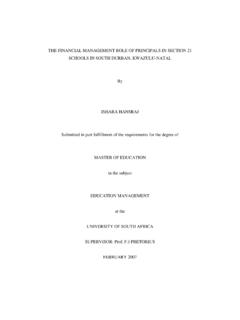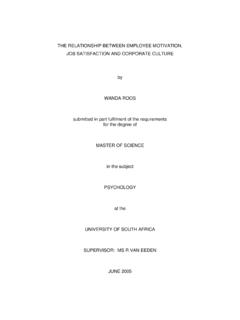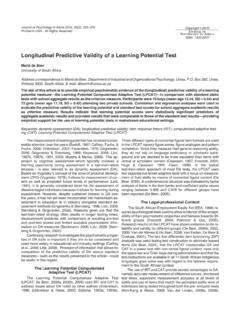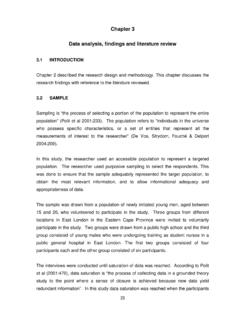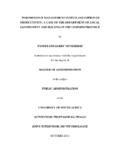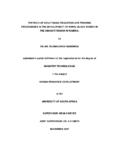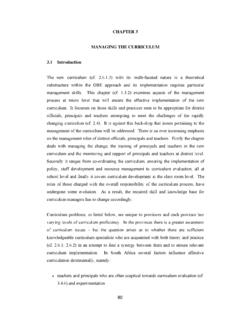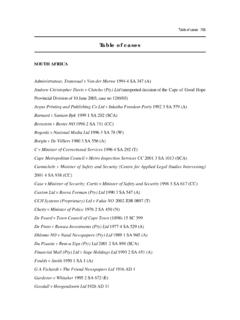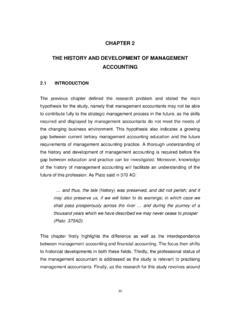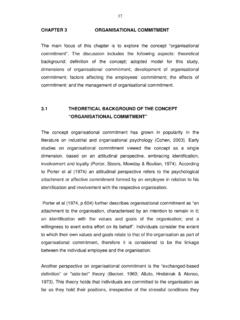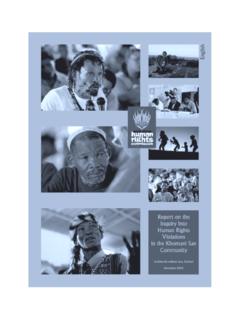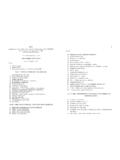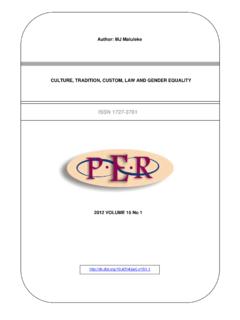Transcription of WOMEN IN THE SOUTH AFRICAN MINING …
1 WOMEN IN THE SOUTH AFRICAN MINING industry : AN. occupational health AND safety perspective . Inaugural Lecture: LI Zungu 20 October 2011. SHOW SLIDE 1. It seems fitting to begin my inaugural lecture with wise words from Clare Boothe Luce words, that hold an important place in my personal drive to succeed. Because I am a woman, I must make unusual efforts to succeed. If I fail, no one will say, "She doesn't have what it takes." They will say, " WOMEN don't have what it takes." Clare Boothe Luce I stand here before you this evening as testament of the fact that as WOMEN we have all that it takes and there is no better place where this is demonstrated than within the SOUTH AFRICAN MINING industry (SAMI). Hence, the premise of my lecture is on occupational health and safety of WOMEN in MINING . Given the fact that work should take place in a safe and healthy working environment, WOMEN in MINING have special occupational health and safety needs that must be 1.
2 Met on an individual basis with due concern to protect their well-being at work. OUTLINE OF THE ARGUMENT. Since our attainment of democracy in 1994, the SOUTH AFRICAN government has made and implemented a number of policies and legislative changes aimed at fast tracking economic growth in pursuit of a better life for all citizens. And as such, the government recently adopted a number of strategies aimed at opening up the MINING sector for previously disadvantaged individuals, including WOMEN as part of its economic empowerment policy and in line with the Employment Equity Act. Of equal importance is the fact that the International Labour Organization has classified WOMEN workers as vulnerable workers with special occupational health needs. (hence the focus of my address this evening). SHOW SLIDE 2.
3 In 1995 during the 12th joint assembly, the International Labour Organization and the World health Organization Committees defined the aims of occupational health , which include: 2. The promotion and maintenance of the highest degree of physical, mental and social well-being of workers in all occupations;. The prevention among workers of departures from health caused by their working conditions;. The protection of workers in their employment from risks resulting from factors adverse to health ; and The placing and maintenance of the workers in an occupational environment adapted to his/her physiological and psychological capabilities. SHOW SLIDE 3. This presentation aims to argue the case of WOMEN as employees in the MINING industry from an adapted feministic perspective . Feminism will be viewed as the notion that WOMEN are unique individuals with inherent specific health needs.
4 Thus, four inherent assumptions hold the key to the way WOMEN 's role within MINING must be seen: - although WOMEN have special needs, they qualify for the same rights as men;. - a woman can perform tasks that were and still are supposedly limited to men;. - you don't have to be anti-man to be pro-woman; and that 3. - WOMEN do not wish to have power over men, but over themselves. Given that MINING is one of SOUTH Africa's most important economic sectors as it remains an important driver of the country's economy, the inclusion of WOMEN in this crucial sector has many implications for the industry , key stakeholders and the society at large. On the other hand, it can be argued that the introduction of WOMEN in MINING challenges the very male, macho gender stereotype and introduces new challenges for mineworkers, the MINING industries as well as the MINING bargaining council.
5 SHOW SLIDE 4. WITH REGARDS TO LEGAL FRAMEWORKS RELATED TO. GENDER EMPLOYMENT. It is important to note that The history of WOMEN in MINING has noteworthy legal genesis which has arisen from a number of landmark legal developments. Significantly, the Minerals and Petroleum Resources Development Act actively encourages entry of historically disadvantaged individuals to participate in the MINING sector. The greatest challenge for the MINING industry has been to introduce and ensure full incorporation of WOMEN into the 4. traditionally male-dominated sector. The Second Annual WOMEN in MINING Conference1 held in 2008, acknowledged that there were significant hurdles to overcome in terms of commitments made during the MINING Charter process. However, a significant advance in the MINING industry is the SOUTH AFRICAN MINING Charter, adopted in 2004 which must be commended.
6 The Charter requires MINING industries to actively change the demographic profile of their employees and to ensure that they have plans in place to achieve the target of 10% participation of WOMEN by 2009. The Charter therefore attempts to address the high proportion of male mineworkers and provide opportunities for female miners. Similarly, the Employment Equity Act prohibits employment discrimination on the basis of race, religion or gender in the workplace. This is in addition to the Mine health and safety Act, as amended in 1997 which requires employers to provide healthy and safe working conditions for all employees involved in MINING activities in order to safeguard their health and safety and communities affected by MINING operations. 1. Second Annual WOMEN in MINING Conference; Recruit, Retain and Accommodate WOMEN in MINING Pre and Post 2009.
7 Indaba Hotel Fourways 26 28 March 2008. 5. Section 7 of Chapter 2 of the Constitution of the Republic of SOUTH Africa Act adopted in 1996, which forms part of the Bill of Rights, also affirms the democratic values of human dignity, equality and freedom. The Millennium Development Goals number 1 and 3 are assigned the collective responsibility to promote gender equality and empowerment for WOMEN and to halve the world's poverty by 2015. Also, the Human Resource Development Strategy for SOUTH Africa (HRD-SA) 2010 - 2030 is a call to create a better life for all SOUTH Africans, in order to address some of the most critical challenges that the country still faces, which include among others, unemployment, poverty and income inequality. NB: Whilst these various legislations allow the influx of WOMEN in the MINING industry , substantial amendments needs to be introduced especially since the MINING industry was previously a male dominated environment.
8 One important area that needs urgent attention is the promotion and maintenance of health and safety for WOMEN working underground. 6. GENERAL health AND safety HAZARDS IN THE. SOUTH AFRICAN MINING industry . SHOW SLIDE 5. According to DMR, 2009 annual report, silicosis remains a major cause of premature retirement and death at SOUTH AFRICAN mines due to excessive dust exposure. On the other hand, Tuberculosis continues to be a serious health challenge for the MINING industry and this is exacerbated by the presence of HIV and AIDS. Tuberculosis and HIV/AIDS are significant health risks in the SOUTH AFRICAN MINING industry - much more so than in the general public. This is due to the fact that these diseases are bound up with living and working conditions of miners, such as migrant labour, single sex hostels, undiagnosed active TB and closed ventilation systems in underground mines.
9 Furthermore, exposure to silica in MINING operations together with HIV infection, exacerbates the risk of active TB. (Hermanus, 2007). Noise Induced Hearing Loss is also a significant health hazard due to exposure to high levels of noise in working places (DMR. Annual Report, 2009). 7. SLIDE 6 health AND safety MILESTONES. At the health and safety summit held in 2003, the tripartite stakeholders in MINING reached consensus with regards to targets and milestones for the MINING industry , in order to address the major health and safety hazards of the sector (Hermanus, 2007). The milestones are considered to be the intermediate steps to achieve the following targets for the MINING sector by 2013: Zero injuries and fatalities Elimination of silicosis Elimination of noise-induced hearing loss THE NEED FOR A HEALTHY AND SAFE ENVIRONMENT.
10 FOR FEMALE EMPLOYEES. MINING involves hard physical labour under conditions of extreme discomfort, deafening noise, intense heat and humidity and cramped space. This is exacerbated by anxiety and tension stemming from the need to be constantly on the alert for signs of potential hazards and danger. In SOUTH Africa, there is a paucity of published data on the health and safety concerns and issues of WOMEN in MINING . This is partly because MINING operations have been biased towards the employment of men as opposed to WOMEN . 8. This therefore calls for more attention to be paid to health and safety issues of WOMEN in MINING which include among others, the availability of welfare facilities underground, physiological changes and psychological vulnerability inherent among WOMEN that may affect their health and safety at work, impact of shift work on WOMEN s family lives, personal protective equipment is generally designed for the male physique (based on the history of male dominance in the industry ) and resistance by their male counterparts to fully accept and regard them as equal work partners.
